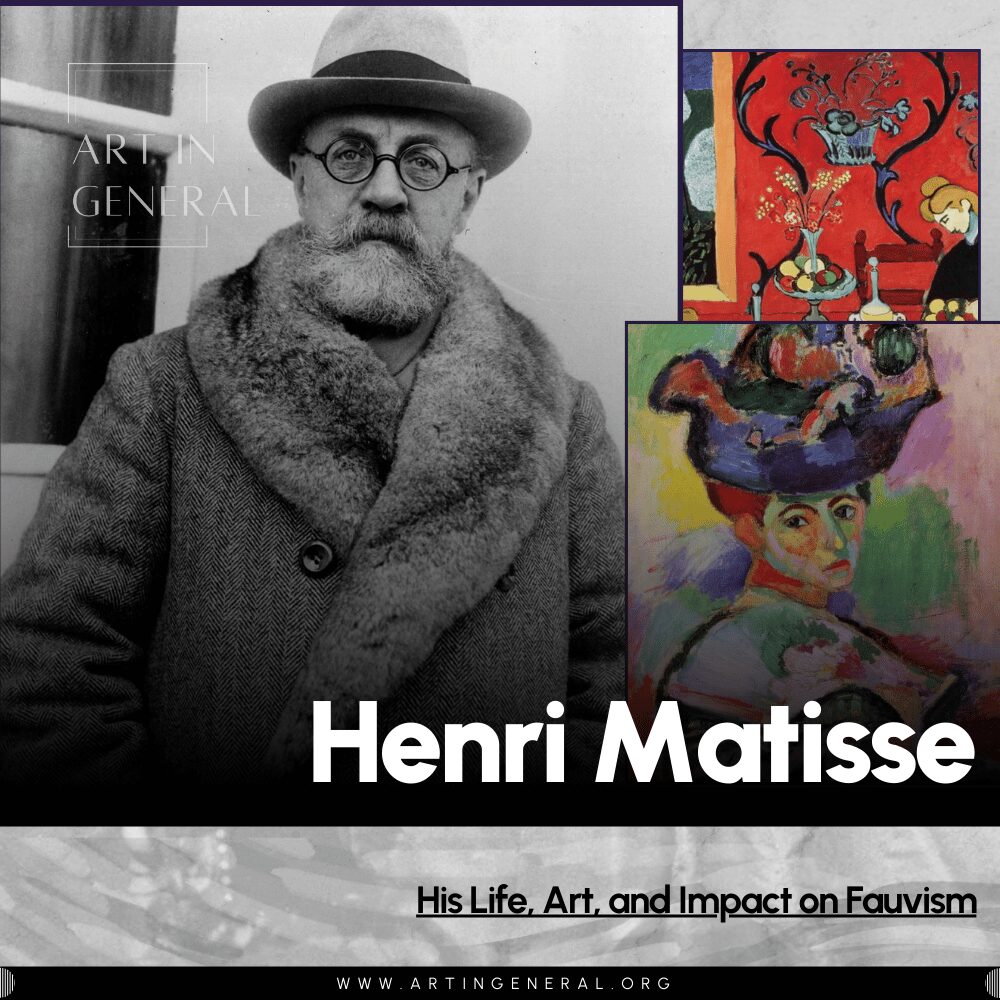Who was Henri Matisse?
Brief overview of Matisse as a pioneering modern artist.
Henri Matisse was a pioneering modern artist and one of the most influential figures of the 20th century. Known for his bold use of color, simplified forms, and expressive compositions, Matisse helped redefine what painting could be. His works, such as La Danse and Woman with a Hat, represent the breakthrough of Fauvism, a movement that embraced intense color and emotional expression over naturalistic representation. Throughout his long career, Matisse continued to innovate, moving from vibrant paintings to cut-outs that transformed paper into powerful, poetic shapes. His legacy as a master of color and form remains central to the story of modern art.
Early Life and Education
Matisse’s birthplace, upbringing, early artistic exposure, and formal training.
Henri Matisse was born on December 31, 1869, in Le Cateau-Cambrésis, a small town in northern France. He grew up in a modest, hardworking family, far from the artistic centers of Europe. Originally studying law, Matisse didn’t consider a career in art until his early twenties, when a period of illness led him to pick up painting for the first time. This discovery was transformative and Matisse later described it as “a kind of paradise.”
In 1891, determined to pursue art seriously, Matisse moved to Paris and enrolled at the Académie Julian, where he studied under respected academic painters. However, just like Monet before him, Matisse became frustrated with traditional expectations and rigid artistic formulas. He sought a more expressive, emotional approach to painting, one that captured feeling rather than imitation. His exposure to artists such as Van Gogh, Gauguin, and Cézanne profoundly shaped his evolving vision, guiding him toward vibrant colors and simplified forms. These foundational years, filled with experimentation and restlessness, set the stage for Matisse’s revolutionary contributions to modern art.
What Does Matisse Paint About?
Themes, subject matter, and artistic focus.
Henri Matisse’s paintings revolve around a joyful exploration of color, harmony, and emotional expression. Instead of striving for perfect realism, he used bold, saturated colors and fluid shapes to convey mood and atmosphere. His works frequently depict interiors, portraits, still lifes, and serene domestic spaces, where patterned fabrics, plants, and props come together in rhythmic, decorative arrangements.
Matisse believed that art should be a source of calm and pleasure like a “soothing, relaxing influence on the mind,” as he famously put it. This philosophy guided his approach to color: he used it not to imitate nature but to express sensation. His willingness to push beyond conventional representation led him to simplify shapes, flatten depth, and use contours like calligraphy. Over time, these explorations shaped his distinctive style, marked by clarity, balance, and emotional warmth.
Matisse and the Birth of Fauvism
Henri Matisse emerged as a leading figure of Fauvism, a bold movement that challenged traditional realism through vibrant, unrestrained color. Alongside artists like André Derain and Maurice de Vlaminck, Matisse embraced color as a direct vehicle for emotion rather than a tool for naturalistic accuracy. Their works shocked critics when first exhibited in 1905 because of their intense, non-natural colors which earned them the nickname Les Fauves, meaning “the wild beasts.”
Matisse’s Woman with a Hat was one of the paintings that fueled this reaction. Its broad, expressive strokes and unexpected color combinations reflected a new vision of art: one that favored emotional truth over literal depiction. Although Fauvism was short-lived, it acted as a launching point for Matisse’s lifelong exploration of expressive color and simplified form. His willingness to break from convention marked him as a central figure in the evolution of modern art.
Key Works and Techniques
Henri Matisse created several iconic works that reshaped modern art through expressive color and simplified form. Some of his most well-known pieces include:

- “Woman with a Hat” (1905): A breakthrough Fauvist painting celebrated for its bold, non-naturalistic use of color and expressive brushwork.
- “La Danse” (1910): A rhythmic composition featuring five dancers in motion, emphasizing energy, movement, and emotional intensity.
- “The Red Room (Harmony in Red)” (1908): Known for its bold, flat expanses of red and decorative patterns, highlighting Matisse’s interest in interior spaces.
- “The Blue Nude” (1907): A striking figure study defined by its sinuous lines and simplified planes of color.
Matisse’s style is marked by his masterful use of vibrant, unmixed colors and fluid, intentionally simplified shapes. Rather than painting from strict observation, he sought to convey the emotional essence of his subject. His brushwork varied from loose and expressive in his early Fauvist years to more controlled and decorative in his later periods. Over time, Matisse developed a unique approach to composition, using bold outlines, flattened perspectives, and rhythmic patterns to unify his scenes. His later “cut-outs” era introduced an entirely new medium: painted paper, cut and arranged into monumental, lyrical forms. These cut-outs demonstrated that even without traditional brushwork, Matisse could create art filled with light, energy, and harmony. His innovative techniques challenged conventional ideas about color, form, and representation, contributing significantly to the evolution of modern art.
La Danse

Artist: Henri Matisse
Year: 1910
Medium: Oil on canvas
Location: The Hermitage Museum, Saint Petersburg, Russia
La Danse captures five figures locked in a circular movement, their bodies intertwined in a primal, rhythmic motion. The bold red of the dancers contrasts sharply with the deep blues and greens of the landscape, creating a dynamic interplay between figure and ground. Here, Matisse distilled motion and emotion into pure, flowing curves, transforming the human body into a symbol of universal energy. The simplicity of the forms, combined with the intensity of color, gives the painting a timeless, almost ritualistic quality. La Danse reflects Matisse’s desire to create art that expresses joy, balance, and vitality.
The Red Room (Harmony in Red)

Artist: Henri Matisse
Year: 1908
Medium: Oil on canvas
Location: The State Hermitage Museum, Saint Petersburg, Russia
The Red Room presents an interior scene that dissolves the boundaries between space, pattern, and color. A dominant field of deep red envelops the room, decorated with swirling blue motifs that blend wall, table, and cloth into a unified decorative plane. Matisse used this flatness deliberately, rejecting traditional perspective to focus instead on harmony and sensation. The presence of fruit, floral arrangements, and an open window introduces both warmth and a gentle sense of depth. This painting is a landmark of Matisse’s expressive approach to interiors, where color becomes the primary vehicle for emotion and balance. Its bold design reveals Matisse’s belief that beauty could be created through the simple interplay of color, shape, and pattern.
Blue Nude (Souvenir of Biskra)

Artist: Henri Matisse
Year: 1907
Medium: Oil on canvas
Location: Baltimore Museum of Art, USA
Blue Nude is a striking figure study known for its sculptural lines and bold use of a single dominant hue. Painted after Matisse’s visit to Algeria, the piece blends influences of North African landscapes with his growing interest in simplified forms. The reclining figure is outlined with confident, flowing contours, while the expressive blue creates both unity and emotional intensity. The painting caused controversy when first exhibited due to its unconventional anatomy and radical color choices, yet it became one of Matisse’s most defining works. Blue Nude showcases his ability to reduce complexity while still conveying depth, sensuality, and movement.
Legacy and Influence
Henri Matisse’s influence on modern art is profound and far-reaching. His fearless approach to color revolutionized painting, inspiring subsequent movements such as Expressionism, Abstract Expressionism, and Color Field painting. Matisse’s belief that art should bring comfort and joy resonated with generations of artists who sought emotional impact over literal representation. His innovative cut-outs later influenced graphic design, illustration, and even contemporary installation art, demonstrating the enduring relevance of his late-career experimentation.
Artists like Mark Rothko, David Hockney, Ellsworth Kelly, and Romare Bearden drew inspiration from Matisse’s clarity, vibrancy, and structural simplicity. Museums around the world continue to celebrate his work, and his cut-out period is now regarded as one of the most important late-life artistic transformations in history. Matisse’s legacy lies not only in his masterpieces but in his unwavering commitment to exploring beauty, color, and emotional truth.
Personal Challenges
Despite his long and successful career, Matisse faced significant obstacles, especially later in life. In the 1940s, he underwent major abdominal surgery that left him bedridden and unable to paint in the traditional way. This period could have ended his artistic production, but instead, Matisse reinvented himself through his cut-out technique. Working with assistants, he used long scissors and colored paper to “paint with scissors,” creating some of the most celebrated works of his career.
Throughout his life, Matisse also struggled financially, especially during his early years when his bold style was often misunderstood or rejected by critics. These challenges created moments of doubt and instability, yet Matisse persisted, guided by an unwavering belief in the expressive power of art. His resilience and ability to transform personal hardship into creative innovation stand as key elements of his artistic identity.
Conclusion
Henri Matisse’s contributions to modern art are immeasurable. With his bold use of color, simplified forms, and harmonious compositions, he helped reshape the foundations of 20th-century painting. From his vibrant Fauvist canvases to the poetic cut-outs of his later years, Matisse consistently sought to capture feeling rather than mere representation. His art reminds us that beauty can be found in balance, clarity, and emotional resonance.
Matisse’s legacy extends far beyond the works themselves, it lives in the countless artists he inspired and in the enduring sense of joy and serenity his creations evoke. Whether through the rhythmic movement of La Danse, the immersive color of The Red Room, or the lyrical shapes of his cut-outs, Matisse demonstrated that art could be both powerful and peaceful, bold and tender. His vision continues to illuminate galleries around the world, inviting viewers to experience color and form in new and transformative ways.
FAQ Section
Q: What are some of Henri Matisse’s most famous paintings?
A: Some of Matisse’s most well-known works include Woman with a Hat, La Danse, The Red Room (Harmony in Red), and Blue Nude. His later cut-outs, such as The Snail and The Blue Nudes, are also iconic.
Q: How would you describe Matisse’s painting style?
A: Matisse’s style is characterized by expressive, vivid colors, simplified forms, fluid lines, and decorative harmony. He often flattened space and used bold patterns to focus on emotional impact rather than realistic detail.
Q: Was Matisse a part of the Fauvist movement?
A: Yes. Matisse was the leading figure of Fauvism, a movement defined by intense, non-naturalistic color and expressive brushwork. Although short-lived, Fauvism played a major role in shaping modern art.
Q: Where can I see Matisse’s artworks today?
A: Matisse’s works are held in major museums worldwide, including The Hermitage Museum, MoMA in New York, the Centre Pompidou in Paris, the Baltimore Museum of Art, and numerous private collections and exhibitions dedicated to his cut-outs and paintings.






Leave a Reply